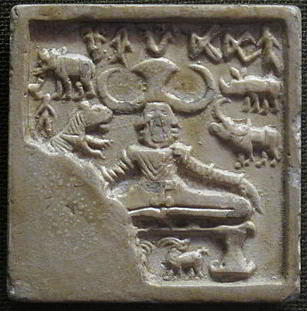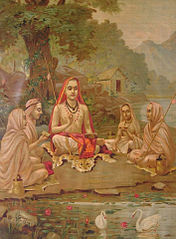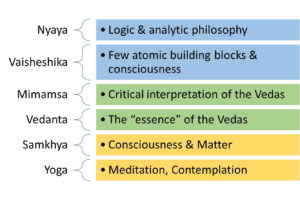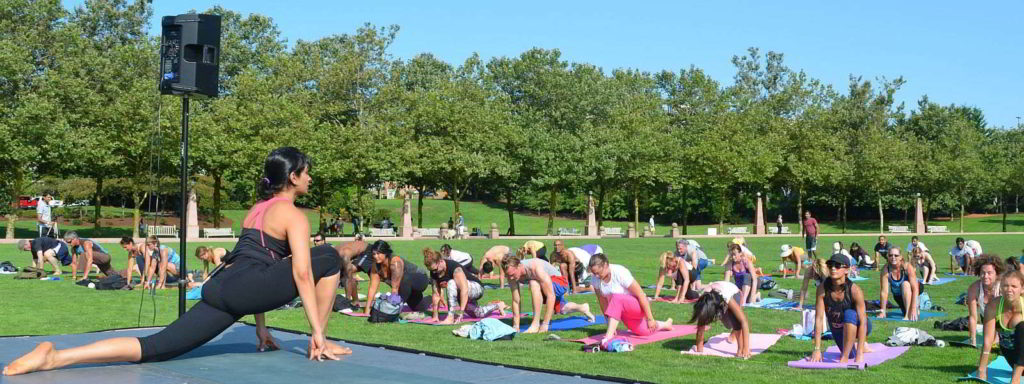Last week we had a workshop that introduced yoga philosophy and the goals and evolution of yoga. Here is a brief overview of what we discussed. Thanks to all the participants for making it a lively and fun class.
What is Yoga Philosophy?
Yoga is much more than a physical practice alone. It is an art as well as a science. The practice of asana is backed by a complete philosophy that is thousands of years old. So what is a philosophy? The dictionary definition of philsophy is “a particular set of ideas about knowledge, truth, the nature and meaning of life, etc.”. To be able to understand yoga philosophy well, we need to trace the origins of yoga.
Origins of Yoga
Yoga is from the Asian subcontinent and originated in India about 5000 years ago. The exact details of it’s origin is largely unknown. However, historians have been able to approximate a date based on a few seals found in the Indus Valley civilization. These seals show a man seated in a variety of what we know as yoga poses. This is perhaps an indication that yoga was practiced by inhabitants of this ancient civilization 5000 years ago.
Guru Shishya Parampara/ Teacher-disciple relationship
Most of the knowledge was passed on for centuries through an oral tradition from teacher to student. It would important to understand the Guru Shishya Parampara of India at this point. A guru is a often described to be the dispeller of darkness (ignorance) & a shishya is a disciple.
In this parampara (tradition), the student is left with the Guru for the remainder of his learning years. The Guru is no ordinary teacher, he is someone who is highly respected in society, who has studied the scared texts and is spiritually closer to enlightenment than the rest of the community. He takes responsibility to teach all important subjects to the worthy student but most importantly teaches the disciple how to walk the path of spirituality. The students spends his years immersed in learning, understanding and helping the Guru in all his tasks. When the Guru feels the shishya has learnt enough to walk his own path, he is sent out to the world to live his life and to spread knowledge.
Shat Darshanas
The Indian society is characterized by Shat Darshanas or six schools of philosophy. They are Nyasa, Vaisheshika, Mimamsa, Vedanta, Sankhya & Yoga. We will consider just Sankhya & yoga for our discussion. Both these philosophies are of the view that the individual self is no different from the universal self. The union between the two is the ultimate goal of yoga. The universal self is called ‘purusha’.
Purusha & Prakruti
Purusha is the soul, the Self, pure consciousness, and the only source of consciousness. The word literally means “man.” Prakriti is manifested creation. It is nature in all her aspects. Purusha, pure and distant, is beyond subject and object. One cannot understand purusha, for that would make it an object. Purusha cannot know or understand anything either, for that would make purusha a subject. Purusha simply just is. But, because of the presence of prakriti, purusha gets attracted to nature and it leads to creation. Purusha becomes trapped inside prakruti
All of yoga is based on this reality, the struggle of purusha getting free from prakruti. It is our body, senses, thoughts, mind that interacts and we get trapped in the mortal world as we know it. The path of yoga helps us get over this constant struggle and return to our original state of blissfulness.
The method of Yoga:
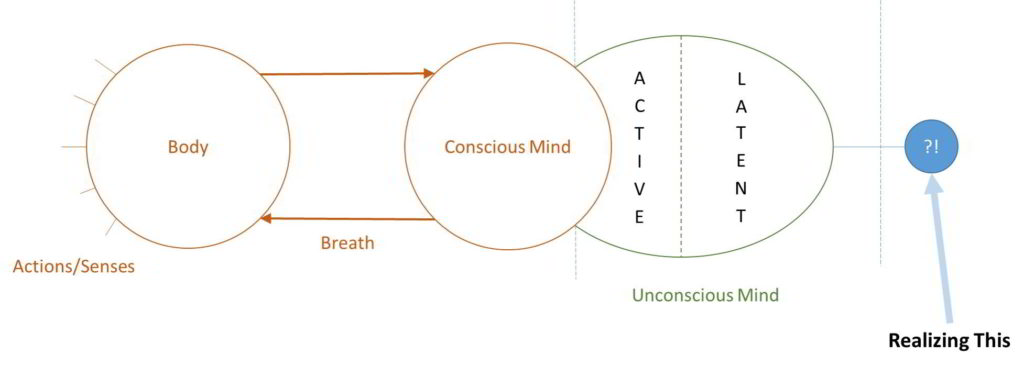
- The way yoga works is it deals with individual components of our being and trains them to a state of freedom. One by one or piece by piece we cleanse ourselves of the entanglement with the external world.
- Our awareness manifests outwards to the world. The subtler consciousness projects outward to the world and gradually we forget about the subtler consciousness. In yoga each aspect is trained. Yoga is complete onto itself. Each level of our being is trained independently while also being trained to be together. Awareness recedes to a state of yoga.
- To be fully aware of the latent state, is a very deep state and an aspect of advanced meditation. It is underneath, beyond or prior to the pictures and words of the active unconsciousness. All sensory experiences such as sights and sounds have been left behind. To consciously rest in the awareness of the latent unconsciousness is to be filled with bliss.
Evolution of Yoga
Yoga in the Vedic Age was mainly ritualistic. People tried to manipulate their external environment to rid themselves of human suffering. For example, they would offer sacrifices of different kinds – material & non materialistic in nature to appease the greater God. But soon they realized that despite their rituals nothing really changed and they continued to suffer. Later this came to be deemed as ‘ignorant’ or ‘useless’ and there came about a need to aspire towards a higher state of being and realization. Thus, classical yoga was born.
To understand classical yoga we will focus on 3 main works – The Upanishads, The yoga sutras of Patanjali & the Bhagavad Gita
Upanishads
are the last chapters of the Vedas. The Vedas are dense and difficult to comprehend while the Upanishads are more concise and easier to interpret. However, there are several Upanishads that mention Yoga – different explanations but very similar. For example: In the Svetasvatara Upanishad, the techinque of yoga is defined as “When he holds the body steady, with the three sections erect, and withdraws the senses into his heart with the mind, a wise person will cross over all the frightening rivers (of embodied existence) by the means of the boat of Brahman. His breathing restrained here (within the body), and his energy under control, he should breathe through one nostril when his breath is depleted. A wise person should control the mind, just as one would a wagon yoked to unruly horses… and engage in the practice of yoga…”
Yoga Sutras Of Patanjali
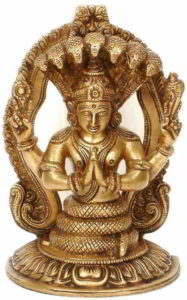
Patanjali – A Depiction
Patanjali is perhaps the most important & authoratative figure in the history and evolution of yoga. Unfortunately not much is known about his life and origins. But we do know
- He codified yoga & put them in a book we know as the “yoga sutras”. They are a collection of 196 aphorisms or sutras explaining the nature of yoga and the path we must walk to get towards that union
- Sutra means ‘thread’
- Sutras were dense, condensed, short sentences that contained to essence of yoga. These were short as everything was passed on orally from teacher to student.
- Sutras are usually meant to be learnt under the guidance of a teacher as it is deep knowledge and cannot be understood easily.
(While the Yoga sutras discuss everything about yoga – the path, the goal, the obstacles, the psychology of mind, the states of blissfulness and much more. To stay within the scope of our topic we will not go into full detail)
What is Yoga according to Patanjali?
- The most classical definition of yoga is “Yogah chitta vritti nirodhah” meaning cessation of mental fluctuations is Yoga. When one reaches a state of complete thoughtlessness, the state where the I-ness disappears that’s the state of yoga or a state of bliss.
The 8 Limbs of Yoga
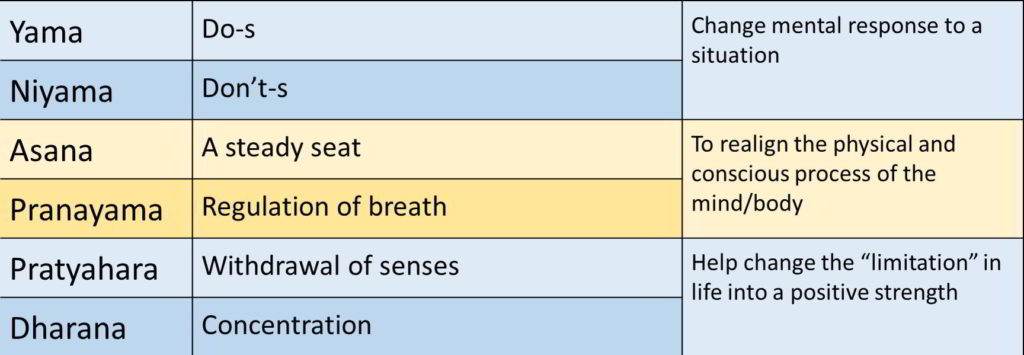
8 Limbs of Yoga
- Yama (social codes): Ahimsa/non violence; satya/truth; asteya/non-possessiveness; brahmacharya/control over senses; aparigraha/non hoarding
- Niyama (personal codes): Soucha/cleanliness; santosha/happiness; tapas/austerity; svadhyaya/self study; Ishvara pranidhanani/surrender to God
- Asana ( physical practice)
- Pranayama (Breath control)
- Pratyahara (Withdrawal of senses)
- Dharana (concentration)
- Dhyana (meditation)
- Samadhi (ultimate freedom/emancipation)
Obstacles to Yoga Practice
Sutras 1.30 to 1.32 talk about the obstacles of practice. They are illness, dullness, doubt, negligence, craving, doubt, misperceptions, failure, instability. In the next verse, he talks about companions to those obstacles are mental and physical pain, sadness and frustration, unsteadiness of the body and irregular breath. These obstacles have been as old as man himself. It is up to us to work through the challenges in our lives to make it to our practice.
Goal of practice
Is to reach a state of kaivalya (emanicipation or ultimate freedom) This is the experience of one’s innermost being or “soul” (the Purusa). Then one becomes free of chains of cause and effect (Karma) which tie us to continual reincarnation. In Kaivalya one is said to exist in peace and tranquility, having attained absolute knowledge of the difference between the spiritual which is timeless, unchanging and free of sorrows, and the material which is not. Yoga is therefore a spiritual quest. However, along the path of yoga, the aspirant also gains health, happiness, tranquility and knowledge which are indicators of progress and an encouragement to continue their practice. Buddhism and other Eastern spiritual traditions use many techniques derived from Yoga.
Role of Asanas
Asanas play a very small role in the grander scheme of things in yoga. Since classical yoga was mainly concerned with the mind, asanas were a mere means to be able to sit up straight, steady & comfortably for meditation. The body was secondary. However with the passage of time as well as the quick spread of yoga, we have not been able to grasp it all. We have gotten stuck and in fact obsessed with the role of asanas. We think yoga = asana but that is untrue. It is like the tip of the iceberg. We should also keep in mind that while the asanas got quick acceptence in modern world, a lot of cultural habits, language and lifestyle could not be carried over successfully.
The Bhagavad Gita: The song of the Lord
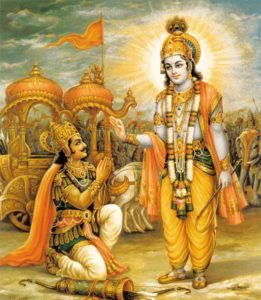
Krishna and Arjuna
What is the Gita
The Bhagavad Gita is an ancient Indian text. It is part of a larger epic called the ‘Mahabharatha’ authored by Vedavyasa. It is 5000 years old. It contains 18 chapters and a total of 700 verses in Sanskrit. It is the 6th book of Mahabharatha.
Setting of the Gita
The Gita is mainly a dialogue between two main characters – Krishna and Arjuna. A great battle is about to commence and Arjuna (the leader) has a mental breakdown. This is where the dialogue begins.
Character Overview:
- Lord Krishna: The stories of Krishna appear across a broad spectrum of Hindu mythology. They portray him in various perspectives – a god-child, a prankster, a divine being, a superhero and a supreme being. ‘Krsna’ in Sanskrit can be translated as dark, black or all attractive.
- Arjuna: son of King Pandu. Arjuna is considered as a supreme warrior- one that has never tasted defeat until the game of dice and feared by all others in battle. He is known for being righteous and brave. Arjuna breaks down at a vital moment and seeks guidance from Lord Krishna. Symbolically, Arjuna represents all of us – our actions, dilemmas, strengths and weaknesses. SIGNIFICANCE OF THE GITA: answers the most fundamental questions that man has today in a simple form.
Chapters in the Gita
In the Gita each of the 18 chapters describes a certain kind of yoga. Each title ends with the word “yoga”. Each chapter deals with a unique way of connecting to the supreme. There are many different paths here as man is unique and no one walks the same path.
We are focusing only on 2 main concepts from the Geeta – Dharma & Karma. We have all heard these words before. But what do they really mean?
Dharma comes from the Sanskrit word ‘Dhr’ which means to upload, maintain or keep. The Geeta tells us how all of us have a ‘sacred duty’ in life. It is up to us to find out what this duty is and to fulfil it. We can understand it as ‘our calling’ in life. It is when we perform our dharma that we contribute to community positively and society at large.
Karma is the cause and effect of our thoughts and actions. Indian philosophy believes that we all have a karmic bank account, where all our good and bad deeds are kept track off. We assume we want good karma but essentially what the Geeta tells us is how we want neither good nor bad karma. We want to achieve a state of being with no karma – this is when we are completely rid of the birth & death cycle.
These 3 sources give us a good understanding of what classcial yoga was all about. It is important to note that none of the 3 sources really dwell on asanas or poses of practice. At best they used asana to describe a steady seat for meditation.
Modern Yoga
Development during the British Rule
During the British rule, a lot of plundering of Indian culture took place because the British thought we were not civilized according to their standards. One of the consequences, was that Yoga schools were shut down and PT was brought in. This caused a lot of Yoga to die out and almost disappear from Indian society.
Post Indian Independence
Towards the 1930s & 40s, certain icons of modern yoga began to emerge. It all started with a man known as Sri. T. Krishnamacharya from Mysuru, India. He studied yoga under his master for many years and is regarded as the father of modern yoga. He is celebrated mainly through his disciples who took yoga to the world. They are, BKS Iyengar, Sri. Pattabhi Jois, Indra Devi & Desikachar
Yoga today
Yoga is now practiced by millions across the globe. This is great for humanity, however a lot of yoga that is being practiced today is merely just asana & some amounts of pranayama. Even asana has been diluted to a mere form of exercise and often teamed with other things (like heat, chocolate, music, weights etc..) that are completely external to classical yoga. Very few practitioners go beyond asana. While we are probably getting healthier with yoga we must remember that there is much more to this ancient art. And it is up to us to preserve it for the generations to come.

